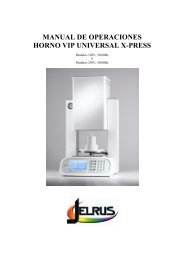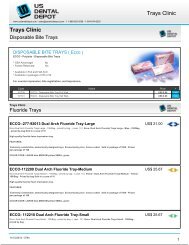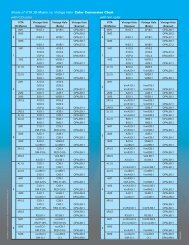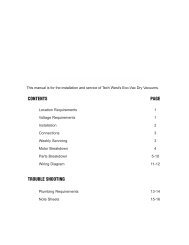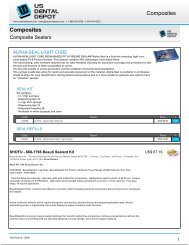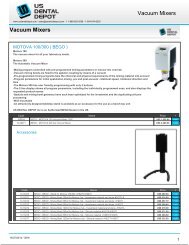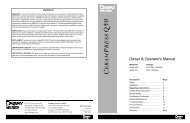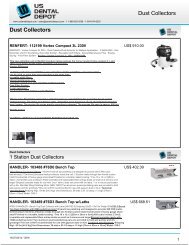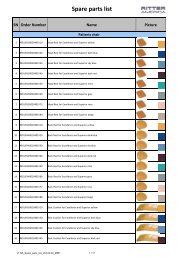We express Acrylics rich in color and texture. - Dental Supplies
We express Acrylics rich in color and texture. - Dental Supplies
We express Acrylics rich in color and texture. - Dental Supplies
Create successful ePaper yourself
Turn your PDF publications into a flip-book with our unique Google optimized e-Paper software.
<strong>We</strong> <strong>express</strong><br />
Sa<strong>in</strong>t Basil Cathedral, Rusia. Visual <strong>rich</strong>es for a chang<strong>in</strong>g aesthetic.<br />
<strong>Acrylics</strong> <strong>rich</strong> <strong>in</strong> <strong>color</strong> <strong>and</strong> <strong>texture</strong>.<br />
GENERAL PRODUCT INFORMATION<br />
Acrylic res<strong>in</strong>s result from a mixture of powdered polymers <strong>and</strong> liquid monomers. They are used for the mak<strong>in</strong>g of most dental prostheses<br />
such as partial or total denture bases, artificial teeth, orthodontic plates, temporary protectors <strong>and</strong> <strong>in</strong>dividual impression trays.<br />
A dental prosthesis is ma<strong>in</strong>ly used for restor<strong>in</strong>g the patient's chew<strong>in</strong>g functions. It is composed of artificial teeth that are adhered to an<br />
acrylic base which will be <strong>in</strong> direct contact with oral tissues..<br />
Some basic features of acrylic denture bases are: biocompatibility with oral tissues, dimensional stability, easy h<strong>and</strong>l<strong>in</strong>g, <strong>color</strong><br />
compatibility with oral tissues, <strong>and</strong> easy wash<strong>in</strong>g, among others.
DEFINITION OF THIS PRODUCT<br />
Acrylic res<strong>in</strong>s are made of polymethyl methacrylate, a solid transparent material of spherical<br />
form that can be pigmented until achiev<strong>in</strong>g any shade or translucency degree to be used <strong>in</strong><br />
dental appliances, <strong>and</strong> methyl methacrylate, a liquid monomer.<br />
When the powder <strong>and</strong> the liquid are mixed <strong>in</strong> the <strong>in</strong>dicated ratios, an easily manipulated dough<br />
is formed. This acrylic dough can be molded <strong>in</strong> a previously- prepared flask <strong>in</strong> which the<br />
polymerization process is completed. The result<strong>in</strong>g prosthesis is ready to be polished <strong>and</strong> used.<br />
CHARACTERISTICS<br />
- Acrylic res<strong>in</strong>s can be molded <strong>in</strong> complex forms with the use of pressure <strong>and</strong> heat.<br />
- They are translucent <strong>and</strong> biocompatible;<br />
- They do not loose their <strong>color</strong> or get pigmented <strong>in</strong> time, <strong>and</strong> are dimensionally stable.<br />
- They are easy to manipulate;<br />
- In their preparation process, they pass through these two phases:<br />
-Filamentous phase<br />
-Plastic phase.<br />
PHYSICAL PROPERTIES AND QUALITY CONTROL<br />
The different properties of acrylics are<br />
evaluated <strong>in</strong> New Stetic’s Quality Control<br />
Laboratory accord<strong>in</strong>g to ISO St<strong>and</strong>ard 1567.<br />
Water Absorption <strong>and</strong> Solubility<br />
The aim of this test is to determ<strong>in</strong>e the<br />
maximum ga<strong>in</strong> or loss <strong>in</strong> weight per volume<br />
unit of acrylic; water absorption <strong>and</strong> solubility,<br />
respectively, are accurately tested while the<br />
structure stays dur<strong>in</strong>g a certa<strong>in</strong> period of time<br />
<strong>in</strong> moisture conditions at body temperature.<br />
Acrylic is not soluble <strong>in</strong><br />
saliva or <strong>in</strong> any other oral<br />
fluid.<br />
Porosity<br />
Porosity of material is evaluated through the<br />
use of fabricated acrylic plates with a surface<br />
that is free from imperfections <strong>and</strong> porosities.<br />
Flexural Strength <strong>and</strong> Flexural Modulus<br />
Flexibility of material is evaluated through the<br />
use of test-tubes made <strong>in</strong> form of plates, <strong>in</strong><br />
order to ensure the material’s resistance to<br />
fractures when the f<strong>in</strong>ished product is used<br />
dur<strong>in</strong>g the chew<strong>in</strong>g activity.<br />
Color Stability<br />
A heat-polymerized acrylic sample is exposed<br />
to ultraviolet rays <strong>and</strong> it is later compared to<br />
an acrylic pattern sample not exposed to UV<br />
rays. There must not be any difference <strong>in</strong> <strong>color</strong><br />
between the two samples.<br />
Translucence<br />
An object placed at the opposite side of an<br />
acrylic test-tube must be visible.<br />
Residual Monomer Content<br />
A processed acrylic sample is carefully tested<br />
<strong>in</strong> order to determ<strong>in</strong>e the amount of monomer<br />
content that rema<strong>in</strong>s after the mak<strong>in</strong>g of a<br />
prosthesis. This residual monomer content<br />
must be m<strong>in</strong>imal to ensure the absence of<br />
irritations of oral tissues.<br />
Acrylic Res<strong>in</strong>s
ADVANTAGES<br />
- The size of the f<strong>in</strong>e particles.<br />
- A f<strong>in</strong>ished prosthesis shows a high gloss <strong>and</strong> excellent surface f<strong>in</strong>ish.<br />
- Homogeneous p<strong>in</strong>k <strong>color</strong>s with no ve<strong>in</strong>s.<br />
COMMERCIAL PRESENTATIONS<br />
Powder:<br />
VERACRIL<br />
OPTI-CRYL<br />
Drum:<br />
POWDER<br />
MASTER BOX<br />
X 20 k - 125k<br />
60 g Bottle<br />
Box per 196 bottles<br />
36.0 x 36.0 x 30.2<br />
15.6 k<br />
125 g Bottle<br />
Box per 147 bottles<br />
33.8 x 33.8 x 33.8<br />
22.1 k<br />
250 g Bottle<br />
Box per 30 bottles<br />
39.8 x 24.8 x 27.3<br />
9.6 k<br />
500 g Bottle<br />
Box per 50 bottles<br />
56.3 x 38.8 x 35.6<br />
28.62 k<br />
1000 g Bottle<br />
Box per 15 bottles<br />
52.8 x 32.8 x 19.3<br />
17.7 k<br />
Liquid:<br />
LIQUID<br />
MASTER BOX<br />
POWDER<br />
LIQUID<br />
55 ml Bottle<br />
Box per 200 bottles<br />
49 x 25.2 x 36<br />
24.3 k<br />
INDIVIDUAL<br />
40 g Bottle<br />
55 ml Bottle<br />
110 ml Bottle<br />
Box per 100 bottles<br />
56.5 x 29 x 23.5<br />
22 k<br />
KIT<br />
8 bottles with 40 g<br />
of powder + 2<br />
55 ml bottles<br />
250 ml Bottle<br />
Box per 50 bottles<br />
36 x 36 x 30.2<br />
21 k<br />
NOVACRYL<br />
-just for export-<br />
500 ml Bottle<br />
Box per 25 bottles<br />
21 x 42.5 x 42.5<br />
20.13 k<br />
POWDER<br />
LIQUID<br />
1000 ml Bottle<br />
Box per 12 bottles<br />
39 x 29.5 x 29.5<br />
15 k<br />
INDIVIDUAL<br />
40 g bottle<br />
55 ml bottle<br />
KIT<br />
4 bottles with 40 g<br />
of powder + 2<br />
bottles with 55 ml<br />
Gallon (3785 ml)<br />
Box per 4 gallons<br />
30.5 x 30.5 x 30.5<br />
14.9 k<br />
KIT<br />
DURACRYL<br />
Powder + Liquid<br />
60 g bottle 55 ml blottle<br />
KIT<br />
Master Box<br />
<strong>We</strong>ight<br />
EZ CRYL<br />
Powder + Liquid<br />
500 g bottle 225 ml bottle<br />
56.3 X 38.8 X 35.6<br />
26 k<br />
Individual Presentation: Powder 60 g bottle <strong>and</strong> Liquid 55 ml bottle<br />
Acrylic Res<strong>in</strong>s
Veracril<br />
Acrylic Res<strong>in</strong><br />
Self - Cure<br />
Opti-cryl<br />
Features<br />
This self-cure acrylic res<strong>in</strong> -polymer <strong>and</strong> monomer- is used for repair<strong>in</strong>g dental<br />
prosthesis <strong>and</strong> the mak<strong>in</strong>g of orthodontic <strong>and</strong> orthopedic appliances.<br />
- The total amount of time required for repair<strong>in</strong>g different acrylic structures or for<br />
mak<strong>in</strong>g orthodontic appliances is 10 m<strong>in</strong>utes approximately, with an average<br />
work time of 4 m<strong>in</strong>utes.<br />
- This res<strong>in</strong> is highly resistant to fractures <strong>and</strong> does not require heat treatment for<br />
its polymerization.<br />
- It allows an easy cutt<strong>in</strong>g <strong>and</strong> polish<strong>in</strong>g <strong>and</strong> recuperates its orig<strong>in</strong>al gloss.<br />
- A greater naturalness is achieved when the right selection of a <strong>color</strong> shade is<br />
made for each patient.<br />
- An optimal dimensional stability can be achieved when the right liquid-topowder<br />
ratio is used as <strong>in</strong>dicated.<br />
Instructions for use<br />
Acrylic Mixture Ratios:<br />
<strong>We</strong>ight ratio: Two parts of Self-cure VERACRIL® Polymer + One part of Selfcure<br />
VERACRIL® Monomer.<br />
Volume ratio: Three parts of Self-cure VERACRIL® Polymer + One part of Selfcure<br />
VERACRIL® Monomer.<br />
Preparation of Acrylic Dough:<br />
- The acrylic dough is prepared <strong>in</strong> an adequate conta<strong>in</strong>er (a dappen dish or a glass,<br />
silicon, or porcela<strong>in</strong> conta<strong>in</strong>er).<br />
- The polymer is poured over the monomer <strong>in</strong> the <strong>in</strong>dicated ratios. The mix<strong>in</strong>g is<br />
cont<strong>in</strong>ually made crosswise dur<strong>in</strong>g 30 seconds approximately <strong>in</strong> order to ensure the<br />
complete <strong>in</strong>corporation of polymer <strong>and</strong> monomer particles.<br />
- Put a lid on the conta<strong>in</strong>er for avoid<strong>in</strong>g the entrance of air until the acrylic dough<br />
reaches its filamentous phase (when the mixture comes <strong>in</strong> contact with a spatula,<br />
filaments can be seen).<br />
- F<strong>in</strong>ally, proceed to make the reparation of prosthesis.<br />
Work Time<br />
This mixture allows a work time from 3 to 5 m<strong>in</strong>utes approximately, at a room<br />
temperature of 23 ºC ±2 ºC.<br />
Cur<strong>in</strong>g time:<br />
This mixture has a self-cur<strong>in</strong>g average time of 10 m<strong>in</strong>utes approximately.<br />
These <strong>in</strong>tervals can vary accord<strong>in</strong>g to the room temperature of the site.<br />
Polish<strong>in</strong>g<br />
Polish<strong>in</strong>g of prosthesis will be made accord<strong>in</strong>g to the current procedures <strong>and</strong><br />
techniques <strong>in</strong> practice <strong>in</strong> dental laboratories.<br />
Acrylic Res<strong>in</strong>s
Veracril<br />
Acrylic Res<strong>in</strong><br />
Heat Cure<br />
Opti-cryl<br />
Features<br />
Heat-cure Acrylic Res<strong>in</strong>s -polymer <strong>and</strong> monomer- are used for the mak<strong>in</strong>g of total or partial prosthesis <strong>and</strong> provisional teeth.<br />
These res<strong>in</strong>s are highly resistant to fractures.<br />
They need thermal energy to polymerize;<br />
They allow an easy cutt<strong>in</strong>g <strong>and</strong> polish<strong>in</strong>g <strong>and</strong> recuperate their orig<strong>in</strong>al gloss.<br />
A maximum naturalness is achieved when the right selection of a <strong>color</strong> shade is made for each patient.<br />
An optimal dimensional stability <strong>and</strong> a dental structure free of <strong>in</strong>ternal <strong>and</strong> external porosities can be achieved when the right liquid-topowder<br />
ratio is used as <strong>in</strong>dicated.<br />
Instructions for use<br />
Acrylic Mixture Ratios:<br />
<strong>We</strong>ight ratio: Two parts of Heat-cure VERACRIL® Polymer + One part of Heat-cure VERACRIL® Monomer.<br />
Volume ratio: Three parts of Heat-cure VERACRIL® Polymer + One part of Heat-cure VERACRIL® Monomer.<br />
Acrylic Res<strong>in</strong>s
Preparation of Acrylic Dough:<br />
The acrylic dough is prepared <strong>in</strong> an adequate conta<strong>in</strong>er (a dappen dish or a glass, silicon, or porcela<strong>in</strong> conta<strong>in</strong>er).<br />
The polymer is poured over the monomer <strong>in</strong> the <strong>in</strong>dicated ratios. The mix<strong>in</strong>g is cont<strong>in</strong>ually made crosswise dur<strong>in</strong>g 30 seconds approximately <strong>in</strong> order<br />
to ensure the complete <strong>in</strong>corporation of polymer <strong>and</strong> monomer particles. Put a lid on the conta<strong>in</strong>er for avoid<strong>in</strong>g the entrance of air until the acrylic<br />
dough reaches its plastic phase (i.e. when the mixture does not adhere to the spatula or to the walls of conta<strong>in</strong>er).<br />
F<strong>in</strong>ally, proceed to make the packag<strong>in</strong>g of the flask.<br />
Work Time<br />
This mixture allows a work time of 10 m<strong>in</strong>utes approximately, tak<strong>in</strong>g <strong>in</strong>to account the room temperature of the site.<br />
Press<strong>in</strong>g<br />
The heat-cur<strong>in</strong>g material is packaged <strong>in</strong> the flask, with a polyethylene sheet between the heat-cur<strong>in</strong>g res<strong>in</strong> <strong>and</strong> the impression model. Apply a slow<br />
pressure of 1500 psi. Take out material from the press. Open the flask to remove the polyethylene sheet <strong>and</strong> cut out the acrylic excess with a spatula.<br />
Close the flask aga<strong>in</strong> <strong>and</strong> apply a def<strong>in</strong>ite 2000 psi pressure to the flask, <strong>in</strong> order to ensure a non-altered vertical dimension.<br />
Cur<strong>in</strong>g<br />
Follow the steps described <strong>in</strong> the chart below.<br />
Time<br />
90 M<strong>in</strong>utes<br />
30 M<strong>in</strong>utes<br />
30 M<strong>in</strong>utes<br />
15 M<strong>in</strong>utes<br />
Process<br />
Water at 73° C<br />
Boil<strong>in</strong>g water 100º C<br />
Room temperature 23° C<br />
Water at room temperature 23° C<br />
Shades<br />
Powder, heat <strong>and</strong> self-cur<strong>in</strong>g availables shades:<br />
Orig<strong>in</strong>al or ve<strong>in</strong>ed p<strong>in</strong>k, clear <strong>and</strong> tooth shade 59-62-65-66-69-77-81<br />
Vita® shades type:<br />
A2 - A3 - A 3,5 - B2 - B3 - C3 - D3 - Incisal.<br />
Acrylic R es<strong>in</strong>s
Novacryl<br />
Self-Cure<br />
Acrylic<br />
CHARACTERISTICS<br />
The formulation of Self-cure NOVACRYL® -LIQUID AND POWDER- is appropriate for the mak<strong>in</strong>g <strong>and</strong> repair<strong>in</strong>g of provisional bridges <strong>and</strong> crowns that must stay<br />
for a short period of time <strong>in</strong>side the patient’s mouth.<br />
Teeth <strong>color</strong>s are similar to natural teeth shades.<br />
A good dimensional stability can be achieved when the right liquid-to-powder ratio is used as <strong>in</strong>dicated by the manufacturer.<br />
The natural translucent effect of enamel is achieved with the use of <strong>in</strong>cisal-coloured NOVACRYL®.<br />
This acrylic res<strong>in</strong> does not require heat treatment for its cure.<br />
INSTRUCTIONS FOR USE<br />
1. Direct Method<br />
Make a complete impression of patient's mouth <strong>in</strong> silicone or alg<strong>in</strong>ate <strong>and</strong> carve the teeth;<br />
Cut all the pontic areas <strong>in</strong> the impression;<br />
If the impression was made with alg<strong>in</strong>ate, wash it <strong>in</strong> warm water <strong>and</strong> remove excess of water with a soft air jet;<br />
Select the <strong>color</strong> of NOVACRYL® powder that best resembles the <strong>color</strong> of patient's<br />
teeth;<br />
Lubricate the support<strong>in</strong>g teeth <strong>and</strong> adjacent g<strong>in</strong>gival tissues with a th<strong>in</strong> cover<strong>in</strong>g of Vasel<strong>in</strong>e for an easy removal of the provisional bridge of NOVACRYL®.<br />
Remark: To avoid the dry<strong>in</strong>g of the alg<strong>in</strong>ate-made<br />
impression, it must be wrapped <strong>in</strong> a wet towel until<br />
the cast<strong>in</strong>g phase.<br />
Acrylic Res<strong>in</strong>s
Mixture Ratio<br />
The volume ratio of the mixture consists of three parts of Self-polymeriz<strong>in</strong>g NOVACRYL® powder + one part of Self-polymeriz<strong>in</strong>g<br />
NOVACRYL® liquid per volume unit.<br />
Preparation of Acrylic Dough:<br />
The polymer is poured over the monomer <strong>in</strong> the <strong>in</strong>dicated ratios. The mix<strong>in</strong>g is cont<strong>in</strong>ually made crosswise dur<strong>in</strong>g 30 seconds<br />
approximately <strong>in</strong> order to ensure the complete <strong>in</strong>corporation of polymer <strong>and</strong> monomer particles. Wait for 30-60 seconds.<br />
When the acrylic dough reaches its desired consistency fluid phase, put it <strong>in</strong> the impression tray by softly fill<strong>in</strong>g the area of pontics <strong>and</strong> support<strong>in</strong>g teeth.<br />
Place the impression tray <strong>in</strong> the patient's mouth <strong>and</strong> apply pressure.<br />
Cur<strong>in</strong>g<br />
Before the beg<strong>in</strong>n<strong>in</strong>g of the exothermic reaction, remove the impression tray from the patient's mouth <strong>and</strong> let the provisional<br />
NOVACRYL® bridge curee <strong>in</strong> the impression tray. The bridge must not cure <strong>in</strong> the patient's mouth. Remove the<br />
NOVACRYL® bridge from the impression tray.<br />
Work Time<br />
This mixture allows a work time from 5 to 6 m<strong>in</strong>utes, accord<strong>in</strong>g to the room temperature of the site.<br />
Polish<strong>in</strong>g<br />
The anatomy <strong>and</strong> contours of the prosthesis are polished accord<strong>in</strong>g to the current procedures <strong>and</strong> techniques <strong>in</strong> practice <strong>in</strong><br />
dental laboratories.<br />
Place carefully the bridge on the support<strong>in</strong>g teeth <strong>and</strong> establish an adequate occlusion.<br />
If adjustment <strong>and</strong> occlusions are satisfactory, cement the NOVACRYL® bridge <strong>and</strong> then verify the patient's occlusion.<br />
To obta<strong>in</strong> a better characterization of the bridge, use Incisal NOVACRYL® range <strong>in</strong> colours to simulate teeth's enamel.<br />
Acrylic Res<strong>in</strong>s
2. Indirect Method:<br />
Provisional Teeth with Self-polymeriz<strong>in</strong>g NOVACRYL®<br />
Build the NOVACRYL® veneers <strong>in</strong> a cl<strong>in</strong>ical model <strong>in</strong> plaster;<br />
Carve the bridge area <strong>and</strong> the support<strong>in</strong>g teeth at approximately 0.5 mm, similarly to a tooth preparation for a crown of a greater<br />
diameter. The edentulous spaces <strong>and</strong> the support<strong>in</strong>g teeth will be replaced later by acrylic veneers. Isolate with plaster-to-acrylic<br />
separator NOVAFOIL <strong>and</strong> condition the acrylic veneers <strong>in</strong> the cl<strong>in</strong>ical model. Select the adequate NOVACRYL® powder.<br />
Preparation of Acrylic Dough:<br />
Prepare a volume unit of acrylic dough <strong>in</strong> a dappen dish by mix<strong>in</strong>g three parts of Self-polymeriz<strong>in</strong>g NOVACRYL® powder + one<br />
part of Self-polymeriz<strong>in</strong>g NOVACRYL ® liquid. The mix<strong>in</strong>g is cont<strong>in</strong>ually made crosswise with a spatula dur<strong>in</strong>g 30 seconds<br />
approximately <strong>in</strong> order to ensure the complete <strong>in</strong>corporation of polymer <strong>and</strong> monomer particles. Avoid air <strong>in</strong>corporation <strong>in</strong>to the<br />
dough. Close the conta<strong>in</strong>er to avoid the dry<strong>in</strong>g of material until the acrylic dough reaches its desired consistency<br />
fluid phase.<br />
Pour immediately the dough <strong>in</strong>to the correspond<strong>in</strong>g area <strong>and</strong> be sure to completely cover the area of the support<strong>in</strong>g or abutment tooth.<br />
Cur<strong>in</strong>g<br />
To avoid retention of material <strong>and</strong> before the beg<strong>in</strong>n<strong>in</strong>g of the exothermic reaction, remove <strong>and</strong> place aga<strong>in</strong> several times the acrylic structure <strong>in</strong> the<br />
plaster cast. Let the acrylic structure polymerize <strong>in</strong> the plaster cast.<br />
SHADES<br />
Work Time<br />
This mixture allows a work time from 5 to 6 m<strong>in</strong>utes, accord<strong>in</strong>g to the room temperature of the site.<br />
Polish<strong>in</strong>g<br />
The anatomy <strong>and</strong> contours of the acrylic structure are polished as necessary, accord<strong>in</strong>g to the current techniques <strong>in</strong> practice <strong>in</strong><br />
dental laboratories.<br />
Place carefully the NOVACRYL® veneer on the support<strong>in</strong>g or abutment tooth <strong>and</strong> establish an adequate occlusion.<br />
If adjustment <strong>and</strong> occlusions are satisfactory, cement the NOVACRYL® veneer <strong>and</strong> verify aga<strong>in</strong> the patient's occlusion.<br />
To obta<strong>in</strong> a better characterization of the bridge, use Incisal NOVACRYL® range-<strong>in</strong> <strong>color</strong>s to simulate teeth's enamel.<br />
NOVACRYL® Tooth-coloured: -59, 62, 65, 66, 67, 69, 77, 81 <strong>and</strong> <strong>in</strong>cisal-<br />
Vita ® Shades Type: -A1, A3, A3.5, B2, B3, C3, D3-<br />
Acrylic Res<strong>in</strong>s
Novacryl<br />
Heat-Cure<br />
Acrylic<br />
CHARATERISTICS<br />
Heat-cure NOVACRYL® is used for the mak<strong>in</strong>g of provisional bridges <strong>and</strong> crowns that will have a long lifetime <strong>in</strong>side the patient’s mouth.<br />
Through thermal treatment, it is possible to obta<strong>in</strong> an optimal cure of this acrylic res<strong>in</strong>; the residual monomer content is m<strong>in</strong>imal.<br />
This avoids irritation <strong>and</strong> lacerations of oral tissues <strong>in</strong> patients.<br />
The right formulation of this res<strong>in</strong> ensures acrylic structures that are highly resistant to the pressure forces exerted by the chew<strong>in</strong>g function.<br />
Its <strong>color</strong>s are more stable under the oral cavity conditions.<br />
INSTRUCTIONS FOR USE<br />
1. Indirect Method<br />
Provisional Teeth with Heat-polymeriz<strong>in</strong>g NOVACRYL® The provisional bridge is built <strong>in</strong> a cl<strong>in</strong>ical model <strong>in</strong> plaster. Carve the pontic area <strong>and</strong> the support<strong>in</strong>g<br />
teeth at approximately +0.5 mm, similarly to a tooth preparation for a crown of a greater diameter. The edentulous spaces <strong>and</strong> the support<strong>in</strong>g teeth will be<br />
replaced later by acrylic veneers.<br />
Submerge the cl<strong>in</strong>ical model <strong>in</strong> water at a room temperature dur<strong>in</strong>g 5 m<strong>in</strong>utes.<br />
Take out the model <strong>and</strong> remove the surface water with an air jet.<br />
Apply vasel<strong>in</strong>e or a special plaster-to-wax separator <strong>in</strong>side the spaces to be restored.<br />
Acrylic Res<strong>in</strong>s
Carve the teeth <strong>in</strong> wax <strong>and</strong> restore the piece's morphology <strong>in</strong> order to obta<strong>in</strong> a passive contact with the oral tissues. The occlusion of bridge teeth is established<br />
by articulat<strong>in</strong>g them with the antagonistic model.<br />
Remove carefully the wax-carved bridge from the cl<strong>in</strong>ical model.<br />
Pour the first addition of plaster stone -Type III- <strong>in</strong>to a flask. Use a pa<strong>in</strong>tbrush to cover with plaster the cavities of the support<strong>in</strong>g or abutment teeth, avoid<strong>in</strong>g<br />
the <strong>in</strong>corporation of bubbles. Submerge the wax-carved bridge <strong>in</strong> fresh plaster with the vestibular part of the dental pieces rema<strong>in</strong><strong>in</strong>g outside the plaster.<br />
Avoid possible retentions.<br />
When the plaster has forged, apply plaster separator NOVAFOIL with a pa<strong>in</strong>tbrush. When it is dry, use a pa<strong>in</strong>tbrush to cover the wax teeth with plaster, tak<strong>in</strong>g<br />
care of mak<strong>in</strong>g a complete cover<strong>in</strong>g of teeth. Complete the pour<strong>in</strong>g of plaster <strong>in</strong> the counter-flask <strong>and</strong> let it forge.<br />
Submerge <strong>in</strong> water at 65ºC for one m<strong>in</strong>ute <strong>and</strong> then, carefully separate the flask parts <strong>in</strong> order to completely remove the wax with hot water <strong>and</strong> detergent.<br />
Apply plaster separator NOVAFOIL on the still-hot plaster <strong>and</strong> let it dry.<br />
Select the <strong>color</strong> of NOVACRYL® powder.<br />
Mixture Ratio<br />
The dough ratio to be used is the follow<strong>in</strong>g:<br />
three parts of heat-polymeriz<strong>in</strong>g NOVACRYL® powder + one part of heat-polymeriz<strong>in</strong>g NOVACRYL® liquid per volume unit.<br />
Prepare the mixture <strong>in</strong> a conta<strong>in</strong>er that cannot react with methyl methacrylate (a dappen dish or a glass, silicone or porcela<strong>in</strong> conta<strong>in</strong>er)<br />
Pour the polymer over the monomer <strong>in</strong> the <strong>in</strong>dicated ratios. Mix crosswise cont<strong>in</strong>ually dur<strong>in</strong>g 30 seconds approximately <strong>in</strong> order to ensure the complete<br />
<strong>in</strong>corporation of polymer <strong>and</strong> monomer particles. Put the lid on the conta<strong>in</strong>er to avoid evaporation <strong>and</strong> dry<strong>in</strong>g of material until the dough reaches its plastic<br />
phase - when the mixture does not adhere to the spatula or to the walls of conta<strong>in</strong>er -. Proceed then with the pack<strong>in</strong>g of the flask.<br />
Press<strong>in</strong>g<br />
Pack the heat-cur<strong>in</strong>g material <strong>in</strong> the previously prepared flask, with a polyethylene sheet between the heat-cur<strong>in</strong>g res<strong>in</strong> <strong>and</strong> the impression model.<br />
Apply a slow pressure of 1500 psi. Take out material from the press. Open the flask to remove the polyethylene sheet <strong>and</strong> cut out the acrylic excess with a<br />
spatula.<br />
Close the flask aga<strong>in</strong> <strong>and</strong> apply a def<strong>in</strong>ite 2000 psi pressure on the flask, <strong>in</strong> order to ensure a non-altered vertical dimension.<br />
Acrylic Res<strong>in</strong>s
Work Time<br />
This mixture allows a work time from 11 to 12 m<strong>in</strong>utes, accord<strong>in</strong>g to the room temperature of the site.<br />
Cur<strong>in</strong>g<br />
Follow the steps described <strong>in</strong> the chart below.<br />
Step Temperature Time Medium<br />
1 73º C 90 m<strong>in</strong> Water<br />
2 100º C 30 m<strong>in</strong> Water<br />
3 23º C 30 m<strong>in</strong> Air<br />
4 23º C 15 m<strong>in</strong> Water<br />
Polish<strong>in</strong>g<br />
The bridge must be cut <strong>and</strong> polished until achiev<strong>in</strong>g the proper adjustment<br />
<strong>and</strong> occlusion. Now, it is ready for cement<strong>in</strong>g. Submerge it <strong>in</strong> water at room<br />
temperature until the moment of putt<strong>in</strong>g it <strong>in</strong>to use.<br />
To obta<strong>in</strong> a better characterization of the bridge, use Incisal NOVACRYL®<br />
range-<strong>in</strong> <strong>color</strong>s to simulate teeth’s enamel.<br />
SHADES<br />
NOVACRYL® Tooth-coloured: -59, 62, 65, 66, 67, 69, 77, 81 <strong>and</strong> <strong>in</strong>cisal-<br />
Vita ® shades type: -A1, A3, A3.5, B2, B3, C3, D3-<br />
Acrylic Res<strong>in</strong>s
Res<strong>in</strong> for Inlay Models<br />
Duracryl<br />
CHARACTERISTICS<br />
This res<strong>in</strong> is an effective alternative for the mak<strong>in</strong>g of <strong>in</strong>lay models used <strong>in</strong> restoration of crowns. It ensures a true <strong>and</strong> exact copy <strong>and</strong> an excellent<br />
adaptation of the restoration of endodontically-treated teeth.<br />
ADVANTAGES<br />
This res<strong>in</strong> can be used not only <strong>in</strong> the dental laboratory but also <strong>in</strong> the dental office, directly <strong>in</strong>side the patient’s mouth.<br />
USES<br />
This res<strong>in</strong> can be used both <strong>in</strong> direct procedures (cl<strong>in</strong>ical <strong>in</strong>terventions) <strong>and</strong> <strong>in</strong> <strong>in</strong>direct procedures (laboratory works).<br />
It is ma<strong>in</strong>ly used <strong>in</strong> the preparation of metallic structures such as p<strong>in</strong>s or radicular reta<strong>in</strong>ers, <strong>in</strong> provisional teeth with metallic re<strong>in</strong>forcement, <strong>in</strong> the<br />
mak<strong>in</strong>g of tooth-shaped “caps” for fixed prostheses, <strong>and</strong> to fabricate weld<strong>in</strong>g keys.<br />
Acrylic Res<strong>in</strong>s
DIRECT TECHNIQUE<br />
Prepare the root canal by completely isolat<strong>in</strong>g the root canal walls with vasel<strong>in</strong>e for an easy removal of the acrylic-made structure. An endodontic<br />
<strong>in</strong>strument with a rolled cotton ball (simulat<strong>in</strong>g a swab) is used for this purpose.<br />
Have a metallic lentulo paste filler –or a guide made with this res<strong>in</strong>– ready to use it later on as <strong>in</strong>tra-radicular retention <strong>and</strong> also as a support <strong>in</strong><br />
the restoration of the tooth piece. The p<strong>in</strong>’s length must be 0.4 mm longer than the size of the crown.<br />
Mix the acrylic powder <strong>and</strong> the acrylic liquid <strong>in</strong> a dappen dish or <strong>in</strong> another adequate conta<strong>in</strong>er <strong>in</strong> a volume ratio of 2:1 (two parts of powder + one<br />
part of liquid).<br />
A spatula or a pa<strong>in</strong>tbrush can be used for rebas<strong>in</strong>g the guide that is impregnated with this res<strong>in</strong>. Then, <strong>in</strong>troduce it <strong>in</strong> the root canal by do<strong>in</strong>g<br />
rotat<strong>in</strong>g movements <strong>in</strong> order to elim<strong>in</strong>ate bubbles. Before the end of the polymerization process of material, remove the rebase <strong>and</strong> re-<strong>in</strong>troduce it<br />
aga<strong>in</strong>, avoid<strong>in</strong>g any retention <strong>in</strong>side the root canal. When the material has completely polymerized, remove the acrylic structure with a pair of<br />
hemostatic forceps.<br />
The excess of material can be removed with a bur or a po<strong>in</strong>t specially mounted for carv<strong>in</strong>gs. The acrylic structure is now ready to be sent to the<br />
laboratory for the mak<strong>in</strong>g of the metallic p<strong>in</strong>.<br />
This res<strong>in</strong> allows a work time between 5 to 6 m<strong>in</strong>utes at a room temperature of 23ºC ± 2ºC.<br />
INDIRECT TECHNIQUE<br />
The <strong>in</strong>direct technique is similar <strong>in</strong> performance to the direct technique. The only difference is that <strong>in</strong> this case, the<br />
work is made on the patient’s impression which is a true copy of the <strong>in</strong>tra-radicular root canal, <strong>in</strong> order to ensure<br />
the adaptation of the p<strong>in</strong> to the root canal.<br />
Mak<strong>in</strong>g of a tooth-shaped cap Have the plaster cast ready with the carved tooth stump isolated with vasel<strong>in</strong>e.<br />
Prepare a quantity of powder <strong>and</strong> a quantity of liquid <strong>in</strong> two dappen glasses.<br />
Moisten the spatula or the pa<strong>in</strong>tbrush with the liquid, impregnate it with the powder, <strong>and</strong> add the material<br />
on the cast. This operation will be repeated as many times as necessary until achiev<strong>in</strong>g the shape <strong>and</strong> a<br />
uniform width. Before completion of the polymerization process, remove the cap from the cast to prevent its<br />
adherence. Put it aga<strong>in</strong> <strong>in</strong> the cast <strong>and</strong> let it polymerize on the tooth stump.<br />
SHADES<br />
This res<strong>in</strong> comes <strong>in</strong> red <strong>color</strong> powder <strong>and</strong> transparent liquid.<br />
Acrylic Res<strong>in</strong>s
Ez-Cryl<br />
Microwave-Cur<strong>in</strong>g<br />
Acrylic Res<strong>in</strong><br />
CHARACTERISTICS<br />
Is an acrylic res<strong>in</strong> that polymerize <strong>in</strong> 10 m<strong>in</strong>utes under microwave heat<strong>in</strong>g. This treatment ensures dentures with no porosities, high<br />
gloss, <strong>and</strong> a m<strong>in</strong>imum of monomer content.<br />
ADVANTAGES<br />
- It’s a pigmented acrylic with cadmium-free colour<strong>in</strong>gs;<br />
- It improves the work<strong>in</strong>g time up to 90%;<br />
- Thanks to its specific features, it can be subjected to high temperatures <strong>in</strong> a short period of time. As a result of this, a m<strong>in</strong>imal contraction is<br />
produced.<br />
- It allows a high gloss <strong>in</strong> a lesser period of time.<br />
Characteristics of the Flask<br />
INSTRUCTIONS FOR USE<br />
Microwave oven<br />
The microwave oven to be used for polymerization purposes must have<br />
the follow<strong>in</strong>g features:<br />
Power: 800 - 1300 watts;<br />
10 power levels m<strong>in</strong>imum;<br />
M<strong>in</strong>ute timer chronometer;<br />
Rotat<strong>in</strong>g <strong>and</strong> removable glass dish.<br />
The acrylic res<strong>in</strong> for microwave polymerization must be processed <strong>in</strong> a flask<br />
with the follow<strong>in</strong>g characteristics:<br />
The flask must not be metallic;<br />
It must be res<strong>in</strong>-made, of resistant ceramics specially designed for microwave<br />
treatment;<br />
It must be a high-impact flask;<br />
It must have a precise clos<strong>in</strong>g <strong>and</strong> a mechanic adjustment <strong>in</strong> all its ends. This<br />
way, it can resist the <strong>in</strong>dicated pressure for a proper pack<strong>in</strong>g.<br />
Acrylic Res<strong>in</strong>s
Flask<strong>in</strong>g Techique<br />
Use the conventional teeth-fil<strong>in</strong>g technique <strong>and</strong> conventional wax<strong>in</strong>g.<br />
Isolate with Vasel<strong>in</strong>e all the <strong>in</strong>ner surface of the flask to prevent adherence of plaster to the flask.<br />
Pour common plaster (Type II) on the low surface of the flask. Position the impression, avoid<strong>in</strong>g the formation of retentions. Place<br />
the occlusal surfaces of teeth <strong>in</strong> parallel to the base of the flask to avoid dislocation of teeth dur<strong>in</strong>g the press<strong>in</strong>g stage.<br />
When the plaster has forged, isolate its surface with plaster-to-plaster <strong>and</strong> plaster-to-acrylic separator (Novafoil plaster separator<br />
is recommended). Complete the fill<strong>in</strong>g of the flask with plaster stone (Type III) by cover<strong>in</strong>g completely the prosthesis.<br />
Wax Removal<br />
Wait for 30 m<strong>in</strong>utes until completion of the second phase of the forg<strong>in</strong>g of plaster. Use the traditional wax release method or the<br />
microwave heat<strong>in</strong>g method to remove the wax.<br />
To remove the wax us<strong>in</strong>g the microwave heat<strong>in</strong>g method, put a water-moistened cotton on the wax excess, adjust the flask, <strong>and</strong> place<br />
it <strong>in</strong> the microwave oven. The microwave oven must be programmed for two m<strong>in</strong>utes at its highest power. Take the flask out from the<br />
microwave oven, remove the cotton, <strong>and</strong> verify the absence of any wax layer on the plaster surface. If it is still necessary, use hot<br />
water <strong>and</strong> detergent.<br />
Application of plaster separator<br />
In the hot flask, apply a f<strong>in</strong>e coat<strong>in</strong>g of Novafoil separator on the plaster. Let it dry.<br />
Preparation of Acrylic Dough<br />
Use three parts of polymer + one part of monomer, per volume unit.<br />
Prepare the acrylic dough <strong>in</strong> a glass or porcela<strong>in</strong> conta<strong>in</strong>er. Pour the polymer over the monomer <strong>in</strong> the <strong>in</strong>dicated ratios <strong>and</strong> mix the<br />
parts with a spatula until a complete <strong>in</strong>corporation of polymer <strong>and</strong> monomer particles is achieved <strong>and</strong> there is homogeneity <strong>in</strong> the<br />
acrylic dough. Incorporation of bubbles dur<strong>in</strong>g the mix<strong>in</strong>g with the spatula must be always avoided. Put a lid on the conta<strong>in</strong>er until<br />
the dough reaches its filamentous phase <strong>and</strong> is ready to be packed.<br />
Pack<strong>in</strong>g<br />
Put the acrylic dough <strong>in</strong> its filamentous phase <strong>in</strong> a flask. Cover with a polyethylene sheet <strong>and</strong> close the flask.<br />
Acrylic Res<strong>in</strong>s
Beg<strong>in</strong> the first low press<strong>in</strong>g until reach<strong>in</strong>g a 1500 psi pressure.<br />
Open the flask <strong>and</strong> remove the polyethylene sheet. Remove excess of acrylics with a spatula. Close the flask aga<strong>in</strong> <strong>and</strong> apply a<br />
def<strong>in</strong>ite 2000 psi pressure. Put the screws.<br />
Microwave Cur<strong>in</strong>g<br />
Put the flask on the oven’s rotat<strong>in</strong>g dish with its screws downside <strong>and</strong> make the cure process by strictly follow<strong>in</strong>g the <strong>in</strong>structions of the “Microwave-<br />
Power-Programm<strong>in</strong>g Chart” appear<strong>in</strong>g below.<br />
Proceed as follows:<br />
First Phase: Let polymerize dur<strong>in</strong>g three m<strong>in</strong>utes at the power <strong>in</strong>dicated <strong>in</strong> the “Microwave-Power-Programm<strong>in</strong>g Chart”.<br />
Second Phase: Wait for four m<strong>in</strong>utes with the microwave oven <strong>in</strong> “off ” position.<br />
Third Phase: Restart polymerization dur<strong>in</strong>g three m<strong>in</strong>utes at the power <strong>in</strong>dicated <strong>in</strong> the “Microwave-Power-Programm<strong>in</strong>g Chart” appear<strong>in</strong>g below.<br />
Take the flask out from the microwave oven <strong>and</strong> let the flask st<strong>and</strong> at room temperature dur<strong>in</strong>g 30 m<strong>in</strong>utes.<br />
Put the flask <strong>in</strong> cold water dur<strong>in</strong>g 15 m<strong>in</strong>utes.<br />
Deflask.<br />
Microwave-Power-Programm<strong>in</strong>g Chart<br />
Power of Microwave<br />
Oven <strong>in</strong> watts<br />
First Phase:<br />
(3 m<strong>in</strong>) Power %<br />
Second Phase:<br />
(4 M<strong>in</strong>) Power %<br />
Third Phase:<br />
(3 M<strong>in</strong>) Power %<br />
800 - 900<br />
40%<br />
0%<br />
90%<br />
1000 - 1100<br />
1200 - 1300<br />
40%<br />
30%<br />
0%<br />
0%<br />
80%<br />
80%<br />
REMARK 2: You can place even two flasks for total prostheses <strong>in</strong>side the oven. In this case, the time must be<br />
<strong>in</strong>creased <strong>in</strong> one additional m<strong>in</strong>ute <strong>in</strong> the third polymerization phase.<br />
Polish<strong>in</strong>g<br />
The polish<strong>in</strong>g is made accord<strong>in</strong>g to the current techniques <strong>in</strong> practice <strong>in</strong> dental laboratories.<br />
Acrylic Res<strong>in</strong>s
MANIPULATION AND CURRENT REGULATIONS<br />
WARNINGS<br />
The use of solvents applied on the acrylic structure is<br />
not recommended s<strong>in</strong>ce it can cause micro-fractures or<br />
material crack<strong>in</strong>g.<br />
The contact with water when manipulat<strong>in</strong>g the acrylic<br />
dough produces <strong>in</strong>corporation of bubbles <strong>in</strong> the acrylic<br />
dough that prevent the compaction of material <strong>and</strong><br />
produce off-white ve<strong>in</strong>s <strong>in</strong> the cur<strong>in</strong>g structure.<br />
Always keep your h<strong>and</strong>s <strong>and</strong> work <strong>in</strong>struments dry to<br />
prevent <strong>in</strong>corporation of bubbles <strong>in</strong> the acrylic structure.<br />
PRECAUTIONARY MEASURES<br />
Acrylic res<strong>in</strong>s are products for external use only. Due to<br />
the nature of these products, it is advisable to work <strong>in</strong><br />
very well ventilated areas, preferably with vapor<br />
extractors, safety glasses, latex gloves, <strong>and</strong> apron.<br />
These products are highly volatile <strong>and</strong> can produce<br />
irritation of mucous membranes <strong>and</strong> possible sk<strong>in</strong><br />
irritation. This is why all k<strong>in</strong>ds of safety measures must<br />
be taken.<br />
RECOMMENDATIONS<br />
Avoid permanent contact with sk<strong>in</strong> or eyes <strong>and</strong><br />
<strong>in</strong>halation of vapors.<br />
After direct sk<strong>in</strong> contact, wash the sk<strong>in</strong> with plenty of<br />
water <strong>and</strong> a soft soap.<br />
After <strong>in</strong>halation, take out the patient from the exposure<br />
area <strong>and</strong> move him/her to a ventilated place. If<br />
necessary, supply the patient with oxygen or give<br />
artificial breath<strong>in</strong>g.<br />
In case of direct contact with eyes, wash the eyes with<br />
plenty of water dur<strong>in</strong>g 15 m<strong>in</strong>utes. If harmful effects<br />
persist, see the doctor immediately.<br />
If swallowed, <strong>in</strong>duce vomit<strong>in</strong>g <strong>and</strong> see the doctor<br />
immediately.<br />
STORAGE<br />
Acrylic monomers <strong>and</strong> polymers must be stored <strong>in</strong> cool,<br />
dry, <strong>and</strong> well ventilated areas, protected from direct<br />
light, heat or ignition sources.<br />
PRECAUTIONS CONCERNING<br />
MANIPULATION AND TRANSPORTATION<br />
Tolerance of these acrylic res<strong>in</strong>s is 410 mg per m³ of air, for<br />
8 hour-work exposures, accord<strong>in</strong>g to OSHA.<br />
These acrylics can be transported <strong>in</strong> glass, metallic or plastic<br />
conta<strong>in</strong>ers. If product is spilled, it can be <strong>in</strong>c<strong>in</strong>erated or<br />
properly disposed accord<strong>in</strong>g to local<br />
regulations <strong>in</strong>to effect.<br />
The ma<strong>in</strong> fire fight<strong>in</strong>g measures are the follow<strong>in</strong>g:<br />
-Ext<strong>in</strong>guish any open flame <strong>and</strong> ignition source.<br />
-Use fire ext<strong>in</strong>guishers for primary fire sources –ABC Type–<br />
-Personnel <strong>in</strong> charge of fire ext<strong>in</strong>guish<strong>in</strong>g must wear<br />
protective equipment, autonomous breath<strong>in</strong>g equipment, a<br />
whole-protection face mask, <strong>in</strong> positive pressure.<br />
CONFORMITY WITH CURRENT<br />
STANDARDS AND REGULATIONS<br />
All Acrylic products conform to ISO St<strong>and</strong>ard 1567.<br />
These products are recommended for dental use. They must<br />
be manipulated by qualified personnel only.<br />
FREQUENTLY ASKED QUESTIONS<br />
People are currently ask<strong>in</strong>g for coloured acrylic<br />
Biodent Vita, Duratone, <strong>and</strong> Biodent.<br />
Answer// The three most used VITA <strong>color</strong>s will be <strong>in</strong><br />
the market very soon.<br />
Why acrylic liquids <strong>in</strong> small commercial<br />
presentations do not come <strong>in</strong> plastic conta<strong>in</strong>ers?<br />
Answer//Up to now, it has not been possible to get<br />
plastic conta<strong>in</strong>ers that can preserve the acrylic product<br />
as well as it is done by glass conta<strong>in</strong>ers.<br />
Why do acrylic liquids polymerize even if h<strong>and</strong>l<strong>in</strong>g<br />
measures are taken?<br />
Answer//Not only h<strong>and</strong>l<strong>in</strong>g measures must be taken<br />
<strong>in</strong>to account. The transport <strong>and</strong> storage conditions of<br />
acrylic products are equally important, because selfpolymerization<br />
of liquids may beg<strong>in</strong> <strong>in</strong> presence of high<br />
temperatures or direct exposure to sunlight. Moreover,<br />
when us<strong>in</strong>g an acrylic liquid, it can be contam<strong>in</strong>ated by a<br />
polymer <strong>and</strong> the polymerization process beg<strong>in</strong>s if<br />
enough cleanl<strong>in</strong>ess precautions are not taken.<br />
Why is <strong>in</strong>dustrial acrylic apparently thicker?<br />
Answer//Industrial acrylic is thicker because its<br />
granulometry is different from acrylics used for denture<br />
bases <strong>and</strong> dental repairs. In this later case, its use is not<br />
so dem<strong>and</strong><strong>in</strong>g concern<strong>in</strong>g this specific feature, <strong>and</strong> that’s<br />
why its price is much more lower.<br />
The delivery period is too long!<br />
Answer//<strong>We</strong> are tak<strong>in</strong>g the necessary measures to<br />
improve delivery periods.<br />
Acrylic Res<strong>in</strong>s
OBJECTIONS<br />
The quality of New Stetic’s acrylic res<strong>in</strong>s is very good, but the <strong>color</strong>imeter does not co<strong>in</strong>cide with the <strong>color</strong> offered <strong>in</strong> the bottle label!<br />
Answer//The <strong>color</strong>imeter is only a promotional material used to reflect the shades of New Stetic’s acrylics. The similarity <strong>in</strong> shade depends on the thickness with which the<br />
supplied guide is compared.<br />
People compare New Stetic’s acrylics with American acrylics <strong>and</strong> say that particles of the American products are not so f<strong>in</strong>e, excepted the microwave-cur<strong>in</strong>g<br />
acrylics!<br />
Answer//The granulometry of New Stetic’s acrylics does not affect the physical <strong>and</strong> mechanical features required by acrylics for denture bases, accord<strong>in</strong>g to the ISO<br />
St<strong>and</strong>ard 1567.<br />
New Stetic’s transparent acrylic becomes milky <strong>and</strong> with bubbles!<br />
Answer//The milky appearance <strong>and</strong> the presence of bubbles depend on the way you prepare the acrylic dough (for <strong>in</strong>stance, a bad mix<strong>in</strong>g with the spatula) <strong>in</strong> any of the<br />
follow<strong>in</strong>g cases: low pressure <strong>in</strong> the mold<strong>in</strong>g process, manipulation of dough by wet h<strong>and</strong>s or the use of wet conta<strong>in</strong>ers.<br />
New Stetic’s acrylic does not come with <strong>in</strong>structions for h<strong>and</strong>l<strong>in</strong>g, <strong>in</strong>structions for prepar<strong>in</strong>g the acrylic dough, the work time, <strong>and</strong> the polymerization process!<br />
Answer//You <strong>and</strong> your customers will have access very soon to this <strong>in</strong>formation through our <strong>We</strong>b Site www.newstetic.com<br />
Tooth-coloured acrylics offered by New Stetic do not co<strong>in</strong>cide with the correspond<strong>in</strong>g tooth <strong>color</strong>!<br />
Answer//New Stetitic is presently offer<strong>in</strong>g a wide variety of tooth-coloured acrylics from which you can select the one that adapts the best to your dental needs. Based<br />
on our customers’ worries, the Research & Development Department of New Stetitic is permanently analyz<strong>in</strong>g the possibility of mak<strong>in</strong>g improvements to our products<br />
provided that a market dem<strong>and</strong> that can justify such improvement really exists.<br />
Acrylic Res<strong>in</strong>s
Novafoil<br />
Plaster Separator<br />
GENERAL PRODUCT INFORMATION<br />
In dental laboratory works, the plaster separator is used as an <strong>in</strong>sulat<strong>in</strong>g material to avoid the<br />
stick<strong>in</strong>g of plaster surfaces to other materials or to any other plaster surface. To achieve the<br />
purposed goal, only a f<strong>in</strong>e film of this substance will be necessary to produce an effective<br />
<strong>in</strong>sulation.<br />
DEFINITION OF THIS PRODUCT<br />
The plaster separator is a plaster-to-plaster or plaster-to-acrylic un-mold<strong>in</strong>g material that is used <strong>in</strong> the flask process<strong>in</strong>g technique to avoid direct contact of<br />
res<strong>in</strong> with dental plaster without alter<strong>in</strong>g denture dimensions.<br />
CHARACTERISTICS<br />
The right formulation of the plaster separator ensures a complete cover<strong>in</strong>g of the t<strong>in</strong>y porosities of plaster. This will produce an acrylic structure with a smooth<br />
surface <strong>and</strong> high gloss.<br />
The plaster separator keeps the plaster cast with its characteristics <strong>in</strong>tact.<br />
USES<br />
In the flask process<strong>in</strong>g technique, when the plaster is free of wax adherences, apply a th<strong>in</strong> film of plaster separator with a soft-bristled pa<strong>in</strong>tbrush.<br />
The th<strong>in</strong> film of plaster separator must be uniform without thicker areas. It must cover the whole plaster surface.<br />
Let the film to be dried. If you want to obta<strong>in</strong> a better gloss, apply a second layer of plaster separator as th<strong>in</strong> <strong>and</strong> uniform as the first one.<br />
RECOMMENDATIONS<br />
Apply th<strong>in</strong> <strong>and</strong> uniform coat<strong>in</strong>gs. The demould<strong>in</strong>g agent cannot be <strong>in</strong> contact with the surfaces of acrylic res<strong>in</strong> teeth because this can prevent the chemical<br />
bond<strong>in</strong>g between the tooth <strong>and</strong> the denture base.<br />
Do not add water to Novafoil. Otherwise, you can alter the chemical properties of this product.<br />
COMMERCIAL PRESENTATIONS<br />
Bottles : 60 ml, 120 ml, 420 ml<br />
Gallon: 3,785 ml<br />
Acrylic Res<strong>in</strong>s
O-Cryl<br />
Self-cure acrylic res<strong>in</strong><br />
for orthodontic <strong>and</strong><br />
orthopedic appliances.<br />
CHARACTERISTICS<br />
Self-cure O-cryl® -liquid <strong>and</strong> powder- is appropriate for the mak<strong>in</strong>g of orthodontic <strong>and</strong> orthopedic appliances.<br />
The total amount of time required for mak<strong>in</strong>g orthodontic appliances is 10 m<strong>in</strong>utes approximately, with an average work time of 4<br />
m<strong>in</strong>utes.<br />
This acrylic res<strong>in</strong> is highly resistant to fractures <strong>and</strong> does not require heat treatment for its cur<strong>in</strong>g.<br />
It allows an easy cutt<strong>in</strong>g <strong>and</strong> polish<strong>in</strong>g <strong>and</strong> recuperates its orig<strong>in</strong>al gloss.<br />
A greater naturalness is achieved with the right selection of the <strong>color</strong> shade.<br />
An adequate dimensional stability can be achieved when the right liquid-to-powder ratio is used as <strong>in</strong>dicated.<br />
INSTRUCTIONS FOR USE<br />
The self-polymeriz<strong>in</strong>g acrylic liquid must be used <strong>in</strong> its reconstitution with the self-polymeriz<strong>in</strong>g acrylic powder for the mak<strong>in</strong>g of acrylic<br />
supports <strong>in</strong> orthodontic removable appliances.<br />
Mixture Ratio<br />
The volume ratio to be used <strong>in</strong> the acrylic mixture is as follows:<br />
Volume ratio: Two parts of Self-polymeriz<strong>in</strong>g Polymer O-Cryl® powder +one part of Self-polymeriz<strong>in</strong>g Monomer O-Cryl® liquid.<br />
Acrylic Res<strong>in</strong>s
Preparation of Acrylic Dough<br />
Prepare the acrylic dough <strong>in</strong> an adequate conta<strong>in</strong>er (a dappen dish or a glass, silicone, or porcela<strong>in</strong> conta<strong>in</strong>er). Pour the polymer over the monomer <strong>in</strong> the<br />
<strong>in</strong>dicated ratios <strong>and</strong> mix the parts with a spatula until a complete <strong>in</strong>corporation of polymer <strong>and</strong> monomer particles is achieved <strong>and</strong> there is homogeneity <strong>in</strong> the<br />
acrylic dough. Incorporation of bubbles dur<strong>in</strong>g the mix<strong>in</strong>g with the spatula must be always avoided.<br />
Put a lid on the conta<strong>in</strong>er to avoid air <strong>in</strong>corporation.<br />
Proceed then to pour the mixture (<strong>in</strong> its fluid phase) on the cast, until achiev<strong>in</strong>g a total cover<strong>in</strong>g of all retentions of functional wires.<br />
F<strong>in</strong>ally, mold the mixture <strong>in</strong> the cast’s palate zone by moisten<strong>in</strong>g the cast with the self-polymeriz<strong>in</strong>g liquid. Cut the necessary excess of material to mold the<br />
necks <strong>and</strong> the border of the acrylic support on the palate.<br />
While the exothermic reaction takes place, try as possible to cover the acrylic cast with a conta<strong>in</strong>er, for example, the cup you used to mix the plaster.<br />
Work Time<br />
The mixture allows a work time of 3 -5 m<strong>in</strong>utes, at a room temperature of 23°C + 2°C<br />
Cur<strong>in</strong>g Time: (Average Time): 10 m<strong>in</strong>utes.<br />
These <strong>in</strong>tervals may vary accord<strong>in</strong>g to the room temperature of the site.<br />
Polish<strong>in</strong>g<br />
The polish<strong>in</strong>g is made accord<strong>in</strong>g to the current procedures <strong>and</strong> techniques <strong>in</strong> practice <strong>in</strong> dental laboratories.<br />
Shades<br />
O-cryl Liquid for removable orthodontic appliances is available <strong>in</strong> the follow<strong>in</strong>g <strong>color</strong>s: Yellow, Blue, Red.<br />
O-cryl Powder for removable orthodontic appliances is available <strong>in</strong> the follow<strong>in</strong>g <strong>color</strong>s: P<strong>in</strong>k, Yellow, Lemon, Fuchsia,Transparent.<br />
Commercial presentations<br />
Individual 60g plastic bottle (powder)<br />
Individual 55 ml glass bottle (liquid)<br />
Com<strong>in</strong>g soon:<br />
Plastic bottles (powder): 60 g, 125 g, 250 g, 1000 g<br />
Glass bottles (liquid): 55 ml, 110 ml, 250 ml, 1000 ml <strong>and</strong> gallon<br />
Acrylic Res<strong>in</strong>s



